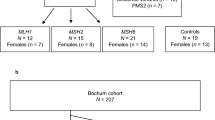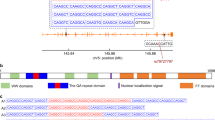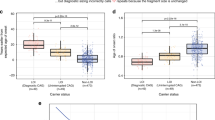Abstract
Huntington's disease (HD) chromosomes contain an expanded unstable (CAG)n repeat in chromosome 4p16.3. We have examined nine families with potential de novo expression of the disease. With one exception, all of the affected individuals had 42 or more repeat units, well above the normal range. In four families, elderly unaffected relatives inherited the same chromosome as that containing the expanded repeat in the proband, but had repeat lengths of 34–38 units, spanning the gap between the normal and HD distributions. Thus, mutation to HD is usually associated with an expansion from an already large repeat.
This is a preview of subscription content, access via your institution
Access options
Subscribe to this journal
Receive 12 print issues and online access
$209.00 per year
only $17.42 per issue
Buy this article
- Purchase on Springer Link
- Instant access to full article PDF
Prices may be subject to local taxes which are calculated during checkout
Similar content being viewed by others
References
Martin, J.B. & Gusella, J.F. Huntington's disease: pathogenesis and management. New Engl. J. Med. 315, 1267–1276 (1986).
Huntington's Disease Collaborative Research Group. A novel gene containing a trinucleotide repeat that is expanded and unstable on Huntington's Disease chromosomes. Cell 72, 971–983 (1993).
Duyao, M.P. et al. Trinucleotide repeat length: instability and age of onset in Huntington's disease. Nature Genet. 4, 387–392 (1993).
Harper, P.S., Aspects of Huntington's Disease. In Huntington Disease Major Problems in Neurology, Vol. 22 (ed. Harper, P.S.), 281–315 (W.B. Sanders Co., London, 1991).
Vogel, F. & Motulsky, A.G., Problems and Approaches. (Berlin, Springer, 1986).
Stevens, D. & Parsonage, M. Mutation in Huntington's chorea. J. Neurol. Neurosurg. Psychiat. 32, 140–143 (1969).
Shaw, M. & Caro, A. The mutation rate to Huntington's chorea. J. med. Genet. 19, 161–167 (1982).
Wolff, G. et al. New mutation to Huntington's disease. J. med Genet. 26, 18–27 (1989).
Baraitser, M., Bum, J. & Fazzone, T.A. Huntington's chorea arising as a fresh mutation. J. med. Genet. 20, 459–475 (1983).
Wallace, D.C. Huntington's chorea in Queensland: A not uncommon disease. Med. J. Austral. 1, 299–307 (1972).
Myers, R.H. et al. Late onset in Huntington's disease. J. Neurol. Neurosurg. Psychiat. 48, 530–534 (1985).
Reed, T.E., Chandler, J.H., Hughes, E.M. & Davidson, R.T. Huntington's chorea in Michigan: 1. demography and genetics. Am. J. hum. Genet. 10, 201–225 (1958).
Batsman, D., Boughey, A.M., Scaravilli, F., Marsden, C.D. & Harding, A.E. A follow-up study of isolated cases of suspected Huntington's disease. Ann. Neurol. 31, 293–298 (1992).
MacDonald, M.E. et al. The Huntington's disease candidate region exhibits many different haplotypes. Nature Genet. 1, 99–103 (1992).
Vonsattel, J-P.G. et al. Neuropathological classification of Huntington's disease. J. Neuropath, exp. Neurol. 44, 559–557 (1985).
Fu, Y.H. et al. Variation of the CGG repeat at the fragile X site results in genetic instability: resolution of the Sherman paradox. Cell 67, 1047–1058 (1991).
Yu, S. et al. Fragile X genotype characterized by an unstable region of DNA. Science 25, 1179–1181 (1991).
Kremer, E.J. et al. Mapping of DNA instability at the fragile X to a trinucleotide repeat sequence p(CCG)n. Science 252, 1711–1714 (1991).
Caskey, C.T., Pizzuti, A., Fu, Y.H., Fenwick, R.G. & Nelson, D.L. Triplet repeat mutations in human disease. Science 256, 784–789 (1992).
Brook, J.D. et al. Molecular basis of myotonic dystrophy: expansion of a trinucleotide (CTG) repeat at the 3′ end of a transcript encoding a protein kinase family member. Cell 68, 799–808 (1992).
Harper, P.S., Harley, H.G., Reardon, W. & Shaw, D.J. Anticipation in myotonic dystrophy: New light on an old problem. Am. J. hum. Genet. 51, 10–16 (1992).
Myers, R.H., Madden, J.J., Teague, J.L. & Falek, A. Factors related to onset age of Huntington's disease. Am. J. hum. Genet. 34, 481–488 (1982).
Myers, R.H. et al. Maternal factors in onset of Huntington's disease. Am. J. hum. Genet. 37, 511–523 (1985).
Anderson, M.A. & Gusella, J.F. Use of cyclosporin A in establishing Epstein-Barr virus-transformed human lymphoblastoid cell lines. In Vitro 20, 856–858 (1984).
Gusella, J.F. et al. A polymorphic DNA marker genetically linked to Huntington's disease. Nature 306, 234–238 (1983).
Feinberg, A.P. & Vogelstein, B. A technique for radiolabelling DNA restriction endonuclease fragments to high specific activity. Addendum. Anal. Biochem. 137, 266–267 (1984).
Taylor, S.A.M., Barnes, G.T., MacDonald, M.E. & Gusella, J.F. A dinucleotide repeat polymorphism at the D4S127 locus. Hum. mol. Genet. 1, 147 (1992).
Wasmuth, J.J. et al. A highly polymorphic locus very tightly linked to the Huntington's disease gene. Nature 332, 734–736 (1988).
Lin, C.S. et al. New DNA markers in the Huntington's disease candidate region. Somat. Cell molec. Genet. 17, 481–488 (1991).
Author information
Authors and Affiliations
Rights and permissions
About this article
Cite this article
Myers, R., MacDonald, M., Koroshetz, W. et al. De novo expansion of a (CAG)n repeat in sporadic Huntington's disease. Nat Genet 5, 168–173 (1993). https://doi.org/10.1038/ng1093-168
Received:
Accepted:
Issue Date:
DOI: https://doi.org/10.1038/ng1093-168
This article is cited by
-
Investigation of the Influence of TBP CAG/CAA Repeats in Conjunction with HTT CAG Repeats on Huntington’s Disease Age at Onset in a Brazilian Sample
Journal of Molecular Neuroscience (2022)
-
Suppression of trinucleotide repeat expansion in spermatogenic cells in Huntington’s disease
Journal of Assisted Reproduction and Genetics (2022)
-
CAG repeat instability in embryonic stem cells and derivative spermatogenic cells of transgenic Huntington’s disease monkey
Journal of Assisted Reproduction and Genetics (2021)
-
Full sequence of mutant huntingtin 3′-untranslated region and modulation of its gene regulatory activity by endogenous microRNA
Journal of Human Genetics (2019)
-
EMQN/CMGS best practice guidelines for the molecular genetic testing of Huntington disease
European Journal of Human Genetics (2013)



